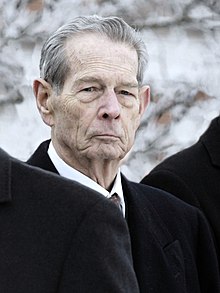

Romania had a monarchical form of government until its forced abolition in 1947 by occupying Soviet forces as part of the Iron Curtain.[1][2] The former King of Romania, Michael I, went into exile from 1947 onwards, culminating in his eventual rehabilitation in 1990 by former Communist officials.
However, he was expelled from the country shortly thereafter by authorities, fearing his popularity might ignite another revolution.[3]
Michael I never renounced the right to his throne, declaring in 2013, "The removal of the monarchy constitutes a new act of violence in the policy for the enslavement of Romania. In these conditions I do not consider myself bound in any way by this act imposed upon me."[2]
In 1992, upon his second visit to Romania since his forced abdication, he drew a crowd of 100,000 to listen to him speak from his hotel window and crowds of over a million spilled into Bucharest.[4] On Michael I's death, public polling drew support for a restored monarchy at an all-time high of 31%.[5]

- ^ "What happened to Romania's monarchy?". The Economist. ISSN 0013-0613. Retrieved 8 August 2023.
- ^ a b "From the archive, 5 March 1948: How Communists forced King Michael out". The Guardian. 5 March 2013. ISSN 0261-3077. Retrieved 8 August 2023.
- ^ "Expelling Former King, Romanians Cite 'Stunt' (Published 1990)". 27 December 1990. Retrieved 8 August 2023.
- ^ Williams, Carol (27 April 1992). "King Michael's Visit Stirs Joy and Unease in Romania". Los Angeles Times. Retrieved 8 August 2023.
- ^ Negrea, Lucian (31 January 2018). "SONDAJ - Românii spun PAS monarhiei: SURPRIZĂ în topul personalităților apreciate din Casa Regală". stiripesurse.ro (in Romanian).
